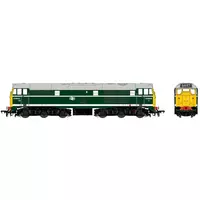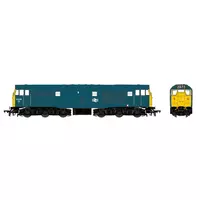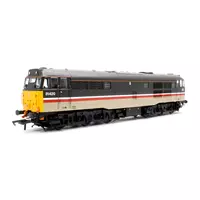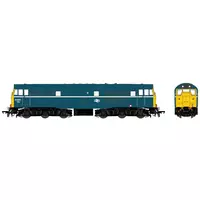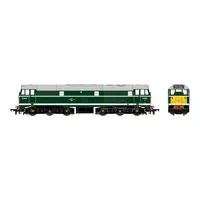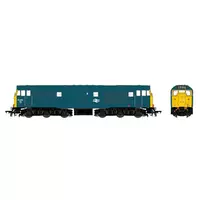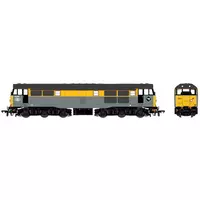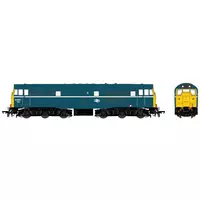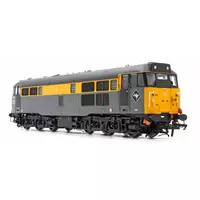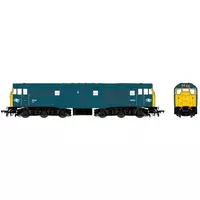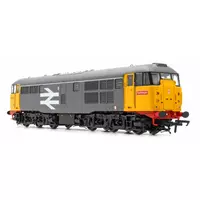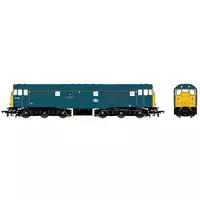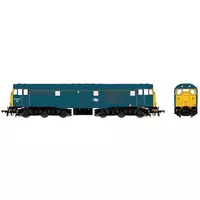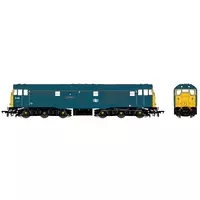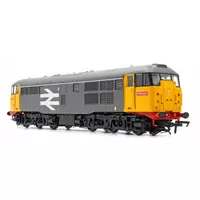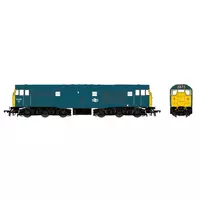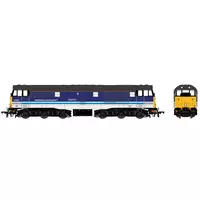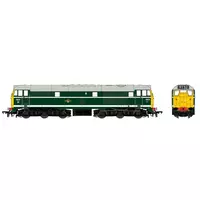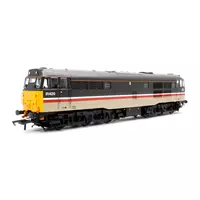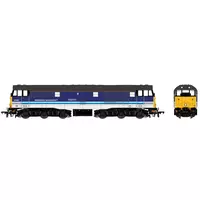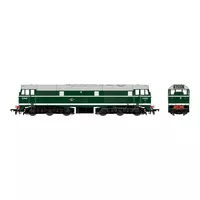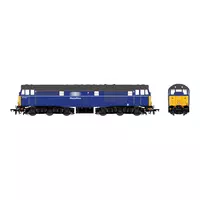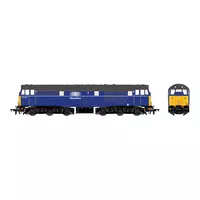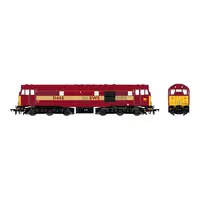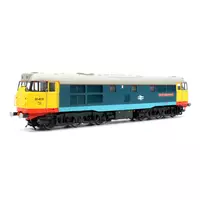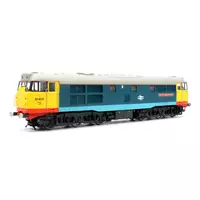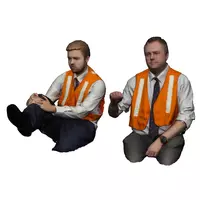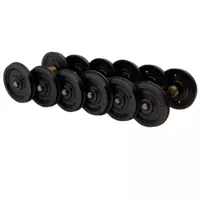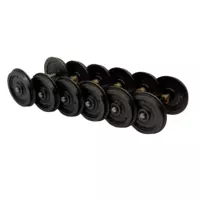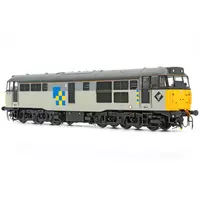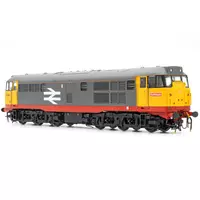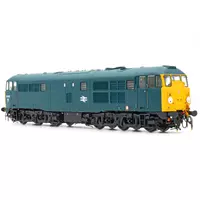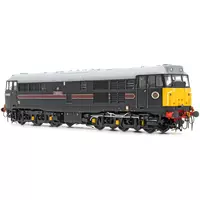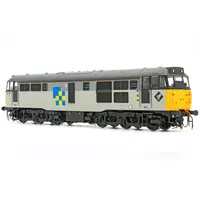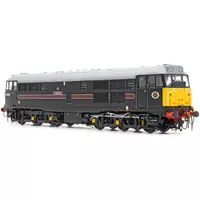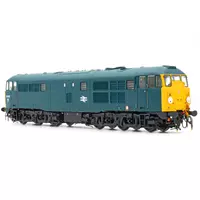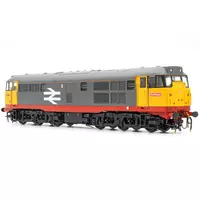Manufacturer catalogue image - please note that pre-release images may be CAD renders or CGI images rather than photographs
Prototype Era
Era 6 (1967 to 1972) British Rail Blue (Pre-TOPS)
Manufacturer description
The models
The modular Accurascale tooling can be adapted to represent nearly all variations of this long-lived class from their as-built appearance right through to the present day. For the discerningly detail minded, this includes three different styles of exhaust port (Mirrlees ‘pilot scheme’ or production and EE), with or without roof fan grille, original/plated boiler port and water filler, additional roof panel for the 17 locos modified in their early days with uprated 1,600hp engines, different NRN roof antenna for both main cab roof styles, as-built ‘Toffee Apple, production and refurbished bodysides, with water filler steps, plated steps and reskinned steps and standard or vertical ‘one piece’ radiator grilles.
The 61 locomotives provided with trip cock gear for working on London Underground routes are also covered, while the Whitaker-style tablet catchers for use on High Dyke iron ore branch in Lincolnshire have also been moulded. The cab fronts feature a myriad of different options with disc and headcode box versions, different nose door and handrail configurations, ‘offset’ and centrally mounted sealed beam headlights, LED-style tail lights, toughened driver’s cab windows and two different ETH jumper locations. The underframe and bogies are highly detailed with numerous separately-applied parts, while the battery boxes also come in original and modified condition, the latter including the extra latches to reduce the likelihood of the doors opening while running.
There are numerous different bufferbeam options allowing the original ‘red circle’ electro-magnetic engine control equipment of the ‘Toffee Apples’ as well as the more standard ‘blue star’ electro-pneumatic gear of the production batch. Vacuum-braking, air braking, control pipes, steam heat and different ETH options are also appropriate to the individual running numbers, as are a full set of miniature snowploughs and a high fidelity one-piece moulding suitable for use with NEM couplers. Accurascale also have some surprise options in store that will be revealed in due course.
The specification continues Accurascale’s ambition to lead the hobby. As well as their standard and well regarded traction, light and sound package the Class 31 introduces working radiator fans – driven from a separate motor – and separately switched tail lights, allowing not just the either end to be illuminated as required, but also individual tail lights or both depending on era. It will also utilise the standard Accurascale specification of ESU PowerBank capacitors for smooth uninterrupted running, ESU Loksound 5 decoder with bespoke DCC sound package by Jamie Goodman with twin speaker set up, including ‘AccuraThrash’ bass reflex speaker. It will also include a wheel flange sensor, automatically playing flange squeal on sound fitted locomotives as they hit curved track for extra realism on factory fitted DCC sound models.
Delivery is expected in Q2 2023ACCURASCALE CLASS 31 SPECIFICATION
- Highly-detailed OO gauge model, 1:76.2 scale on 16.5mm track
- Minimum Radius 438mm (2nd Radius Set-track)
- Die-cast metal chassis
- Bogie with separate footsteps, brake cylinders, speed recorder and end brake rigging
- RP25-110 profile OO gauge wheels
- Brake blocks on bogies in line with wheels
- Scale width wire handrails
- Etched metal/plastic detail parts, incl. grab handles, steps, wipers, etc.
- Etched metal roof grille
- Etched metal pre-painted nameplates, plaques and arrows (if applicable)
- Accurate high-fidelity miniature snowploughs
- Full underbody battery box/air tank detail with pipework
- Fully sprung buffers, multiple pipework variations and screw couplings
- Kinetic NEM coupler mounts at correct height with mini-tension-lock couplers
- DCC ready [21-Pin MTX Socket] or Factory-Installed DCC Sound options
- Two quality speakers with large sound capsules for best possible sound (DCC Sound models only)
- Wheel flange squeal sensor on DCC sound fitted locomotives
- Working radiator fan, driven from separate motor
High Performance traction, to include;
- High quality 5-pole motor with two large flywheels
- Helical Gear box for maximum performance and slow speed running
- Gearing arranged so locomotive can achieve a scale top speed of 90 mph (145 km/h)
- DCC ready with PowerPack capacitor for uninterrupted power
- Outer axles on bogies are driven (sprung dummy centre axle) and all wheel pickup
Fully detailed Lighting Pack, including:
- Directional lighting, DC and DCC
- Switchable Red and white marker lights (red can be switched individual lights or both on)
- Separately switched cab lighting and illuminated, driver’s desk with auto/off on movement
Prototype History
Ordered as a result of the British Transport Commission’s modernisation plan of 1955, the first locomotive – numbered D5500 – was outshopped from Brush Traction’s Kestrel Works, Loughborough, in September 1957. Only the second of the ‘pilot scheme’ designs to be revealed after English Electric’s D8000 Type 1s, the initial 20 members of the class – quickly nicknamed ‘Toffee Apples’ due to the shape of their power handle – were provided with a Mirrlees JVS12T engine. The discovery of metal fatigue issues with this power unit in the early 1960s led to the decision to re-engine the entire fleet, BR choosing the familiar EE 12SVT instead – almost identical to that used in the Class 37 – albeit downrated to 1,450hp.
Their place among the earliest of mainstream diesel designs plus the addition of a Spanner Mk.1 steam generator for train heating came at a cost. Tipping the scales at 107 tons required the rare use of the A1A-A1A wheel arrangement with two powered axles and a non-powered centre axle to spread the load. Despite their low power to weight ratio, even before the final example was delivered in December 1958, further orders eventually totalling 243 locomotives were committed for ‘production’ versions. These commenced delivery in February 1959 – most now with cab roof-mounted headcode boxes replacing the disc style of train identification – with the final example, D5862, being handed over to British Railways in October 1962.
The early 1970s saw 24 locomotives upgraded with 320kW Brush BL100-30 alternators (the same as the Class 45/1s and Class 47s) primarily for ECS duties on the new air-con fleet out of London terminals. They were given the new TOPS sub class 31/4, numbers 31401-31424, while the remainder of the fleet was split under the 1973 TOPS scheme as 31001-31019 (Class 31/0) and 31101-31327 (Class 31/1). Class 30 was reserved for existing Mirrlees engined locomotives, although all were re-engined before TOPS renumbering. A further 44 Class 31/4s were modified between 1983-5, becoming 31425-31468 – the first ‘refurbished’ locos, with two further examples, 31400 and 31469 following in 1987/8 following collision write offs.
The entire fleet was initially allocated to the Eastern Region from new with North Eastern depots later gaining allocations. By the early 1970s increasing numbers were joining the Western Region to replace the hydraulics and by 1988 they had joined the London Midland in sizeable numbers to replace the Class 25s. Although never allocated to the other two regions they were commonly seen on the Southern on inter regional passenger and cross London freight services.
By the early 1990s the Class 31s were starting to see increasing numbers of withdrawals, but two other sub classes were notable for their appearance that decade. Class 31/5 were former ETH-fitted machines with deactivated train heating equipment for use by the departmental sub sector – basically Class 31/4s renumbered by changing the third digit to a ‘5’, while the spot hire and open access operator Fragonset converted a pair of locomotives to Class 31/6 in 1999 with through ETH cabling and controls. These were employed in top and tail formation with a Class 31/4.
After EWS retired the final examples in 2001 the class continued to see regular test train use throughout the decade courtesy of Network Rail, which operated four locomotives, and a handful of other operators. The final NR machines were finally taken out of service in 2017, leaving just a single main line-registered example still working today – Nemesis Rail’s 31128 – although this number is expected to increase. This leaves around 30 preserved Class 31s extant with a handful of stored locomotives with various owners.
Catalogue listing
Model details
Prototype information
* Class names often change over the lifespan of a locomotive, so this is not necessarily the class name used by the operator in the period modelled.
Supplier links are provided for your convenience and do not guarantee that the product is currently available. RailwayModels.uk is not a representative of these suppliers, but may receive a commission when purchases are made through links on this page.


